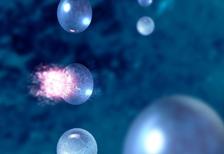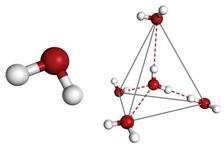Artist's concept of an LCLS X-ray flash hitting a supercooled water droplet. (Credit: Greg Stewart/SLAC)
Using the world's strongest X-ray laser LCLS, an international team of scientists, including researchers from the CFEL at DESY, has probed the internal structure of super-cooled liquid water at minus 46 degrees Celsius for the first time. With falling temperature, the inner structure of super-cooled liquid water increases, reports the team in the scientific journal Nature. The study, led by Prof. Anders Nilsson from the SLAC National Accelerator Laboratory in the US, provides a first glimpse of the properties of water in a largely uncharted "no-man's land". The observations may help to narrow down competing theories for the behaviour of super-cooled water.
"Water is not only essential for life as we know it, but it also has very strange properties compared to most other liquids," explains Nilsson. One example is the density anomaly that makes frozen water (ice) lighter than liquid water. This leads to ice floating up and prevents ponds and lakes from freezing up all the way from the bottom to the top during winter, allowing fish and other creatures to survive below the ice. Also, water has a high boiling point, a high surface tension and a high heat carrying capacity compared to many other liquids.
Usually water freezes at 0 degrees Celsius. But very pure water without any seeds for ice crystallization can remain liquid at temperatures far below the usual freezing point. This super-cooled state can reveal fundamental properties of water. "Scientists had known before that water can remain liquid at extremely cold temperatures, but it has not yet been possible to obtain reliable structural information for liquid water below about minus 38 degrees Celsius", says DESY scientist Dr. Anton Barty from CFEL. The rapid onset of crystallization below minus 38 degrees renders this region an experimentally nearly inaccessible "no-man's land", until at about minus 115 degrees water assumes a glassy, non-crystalline form.
The team now used the ultra-short and super-bright X-ray laser flashes of SLAC's Linac Coherent Light Source LCLS to record the inner structure of tiny droplets of super-cooled water just before they froze up, with an exposure time of just 50 femtoseconds (quadrillionths of a second). "Now, thanks to LCLS, we have finally been able to enter this cold zone that should provide new information about the unique nature of water," says Nilsson.
To measure the structure of super-cooled water, the scientists designed a special liquid injector, that sent water droplets into an evacuated experimental chamber. In the vacuum, some of the water evaporated, cooling the remaining droplet. By adjusting the travel time of the droplets before they were hit by an X-ray flash, the scientists could control the temperature of the water.
"The colder the droplets were, the more of them had already ice crystals in them. But a significant fraction remained all liquid," explains Barty. "There are different, rivalling theories about how liquid water behaves in the 'no-man's land'. Our results show that super-cooled water becomes more and more ordered on a local scale and that the change is continuous and becomes strongly accelerated at these low temperatures." These observations are consistent with theories that assume a phase transition of super-cooled water from a high-density liquid to a low-density liquid at some critical point appearing at high pressure.
But the new findings are just a first step into the "no-man's land". Nilsson hopes to dive to even colder temperatures to see if the unusual properties of liquid water peak at a critical point. "Our dream is to follow these dynamics as far as we can," says Nilsson. "Eventually our understanding of what's happening here in 'no-man's land' will help us fundamentally understand water in all conditions."
SLAC is a multi-program laboratory exploring frontier questions in photon science, astrophysics, particle physics and accelerator research. Located in Menlo Park, California, SLAC is operated by Stanford University for the U.S. Department of Energy Office of Science. SLAC’s LCLS is the world’s most powerful X-ray free-electron laser. Its highly focused beam shines a billion times brighter than previous X-ray sources to shed light on fundamental processes of chemistry, materials and energy science, technology and life itself.
Deutsches Elektronen-Synchrotron DESY is the leading German accelerator centre and one of the leading in the world. DESY is a member of the Helmholtz Association and receives its funding from the German Federal Ministry of Education and Research (BMBF) (90 per cent) and the German federal states of Hamburg and Brandenburg (10 per cent). At its locations in Hamburg and Zeuthen near Berlin, DESY develops, builds and operates large particle accelerators, and uses them to investigate the structure of matter. DESY’s combination of photon science and particle physics is unique in Europe. CFEL is a cooperation of DESY, the University of Hamburg and the Max Planck Society.
(from DESY Press release)
Original publication
"Ultrafast X-ray probing of water structure below the homogeneous ice nucleation temperature"; J. A. Sellberg et al.; Nature, 19 June 2014; DOI: 10.1038/nature13266








